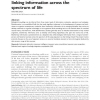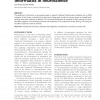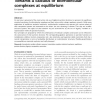BIB
2010
14 years 2 months ago
2010
The emergence of high-throughput technologies for measuring biological systems has introduced problems for data interpretation that must be addressed for proper inference. First, ...
BIB
2007
14 years 2 months ago
2007
Biological knowledge can be inferred from three major levels of information: molecules, organisms and ecologies. Bioinformatics is an established field that has made significant a...
BIB
2007
14 years 3 months ago
2007
It is now almost15 years since the publication of the first paper on text mining in the genomics domain, and decades since the first paper on text mining in the medical domain. En...
BIB
2007
14 years 3 months ago
2007
BIB
2007
14 years 3 months ago
2007
The collection of multiple genome-scale datasets is now routine, and the frontier of research in systems biology has shifted accordingly. Rather than clustering a single dataset t...
BIB
2007
14 years 3 months ago
2007
The application of informatics to neuroscience goes far beyond ‘traditional’ bioinformatics modalities such as DNA sequences. In this review, we describe how informatics is be...
BIB
2007
14 years 3 months ago
2007
The contribution of transposable elements (TEs) to genome structure and evolution as well as their impact on genome sequencing, assembly, annotation and alignment has generated in...
BIB
2007
14 years 3 months ago
2007
An overview is presented of the construction and use of algebraic partition functions to represent the equilibrium statistical mechanics of multimolecular complexes and their acti...
BIB
2007
14 years 3 months ago
2007
Mathematical modelling is increasingly used to get insights into the functioning of complex biological networks. In this context, Petri nets (PNs) have recently emerged as a promi...
BIB
2007
14 years 3 months ago
2007





